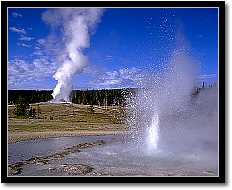Click here to read about our cabin.
Yellowstone National Park is America’s first and foremost National Park, drawing over three million visitors yearly. Established in 1872 by the United States Congress “for the preservation of” its many wonders and “for the enjoyment of the people,” and now encompassing 2.2 million acres, Yellowstone in 2002 is celebrating it’s 130th anniversary. The Park has five entrances and some 370 miles of paved roadway. Situated in the northwest corner of the Wyoming frontier, Yellowstone is a treasure that inspires awe in travelers from around the world, boasting more geysers (about 250 active geysers from amidst 10,000 total thermal features) than anywhere else on the globe.Situated atop a huge volcanic basin, Yellowstone is home to thousands of active thermal features, including the world renowned Old Faithful Geyser. Yellowstone is also known for the spectacular Grand Canyon of the Yellowstone, which is 1200 feet deep and highlighted by the powerful Upper Falls. Yellowstone is also pristine mountain-range wilderness and an open refuge for wildlife, including grizzly bear, elk, American bison, moose and wolf. In recent decades, it has been recognized that Yellowstone and the surrounding area are a biological unit, which is referred to as the Greater Yellowstone Area.

PARK REGULATIONS
All wildlife, especially bison and bears, can be dangerous. Keep your distance! Never approach, harass, or feed any animals, even small ones. It is against the law to approach within 100 yards of bears or within 25 yards of other wildlife or within any distance where harassment occurs. Pets must be leashed; they are prohibited on trails and in the backcountry. Camp and build fires only in designated areas. Hot springs and geyser areas are fragile and unstable; stay on trails to protect yourself and features. Throwing coins and other items into thermal pools dmages them and is illegal. Climbing in the Canyon area is dangerous and is prohibited. Swimming or bathing in thermal pools or streams whose waters originate entirely from a thermal spring or pool is prohibited. Boating and fishing permits are required and availble at ranger stations. Boating is allowed only on lakes, which are dangerously cold. Fishing is limited in the Park. Backcountry permits are required for overnight trips. Never hike alone and always register at the trailhead before your trip. Food must be stored properly. Vehicles and bicycles are prohibited on trails. Maximum speed limit is 45 mph, lower when posted. Drive defensively! Traffic accidents cause more injuries to visitors than natural hazards. Use pullouts to watch wildlife and allow faster traffic to pass. Be alert for pedestrians and bicyclists. Driving off roads is not permitted. Defacing park features, collecting natural or archeological objects, picking wildflowers, and littering are illegal. Store your valuables securely and lock your vehicle. Report thefts or accidents promptly to a ranger. (These regulations are taken from the “Official Visitors’ Guide”.)
Interesting facts about Yellowstone National Park that few people know
1. Yellowstone National Park was established as the first national park in the United States in 1872 and is widely considered the first national park in the world.
2. Yellowstone is home to the largest concentration of geysers in the world, with more than 500 documented geysers. The most famous of these is Old Faithful, which erupts approximately every 90 minutes.
3. Beneath Yellowstone lies one of the world’s largest active volcanic systems. This massive caldera, spanning 45 miles (72 kilometers) across, is responsible for the park’s geothermal features and geysers.
4. The park is home to a variety of wildlife, including grizzly bears, black bears, wolves, bison, elk, and moose. Yellowstone remains one of the few places in the lower 48 states where all these species still exist in significant numbers.
5. The famous Yellowstone Lake, located at 7,732 feet (2,357 meters) above sea level, is considered the largest high-elevation lake in North America. Its pristine waters cover an area of approximately 136 square miles (352 square kilometers).
6. Yellowstone houses the Yellowstone Caldera, which is capable of producing some of the most catastrophic volcanic eruptions known to man. Scientists closely monitor the caldera for any signs of volcanic activity.
7. The park encompasses parts of three different states: Wyoming, Montana, and Idaho. Nearly 96% of the park’s area lies within Wyoming.
8. Yellowstone boasts an impressive network of more than 1,000 miles (1,600 kilometers) of hiking trails, allowing visitors to explore the park’s natural wonders, including majestic waterfalls, hot springs, and canyons.
9. The park’s Grand Prismatic Spring is the largest hot spring in the United States and the third largest in the world. Its vibrant colors, caused by microbial mats, create a mesmerizing sight.
10. Yellowstone is home to the Yellowstone River, which is the longest undammed river in the contiguous United States. It stretches approximately 692 miles (1,114 kilometers) and is known for its scenic beauty and numerous waterfalls, including the famous Lower Falls.
ENTRANCE FEES
Seven Day Pass (good for seven days from issue date) — $20 (per vehicle)
Annual Pass (good for one year from issue date) — $40 (per vehicle)
National Parks Passport (good for one year in all National Parks) — $50 (per vehicle)
Golden Age Passport (lifetime pass for citizens 62 or older) — $10 (per person)
FOR MORE ON YELLOWSTONE NATIONAL PARK SEE: http://www.nps.gov/yell/home.htm